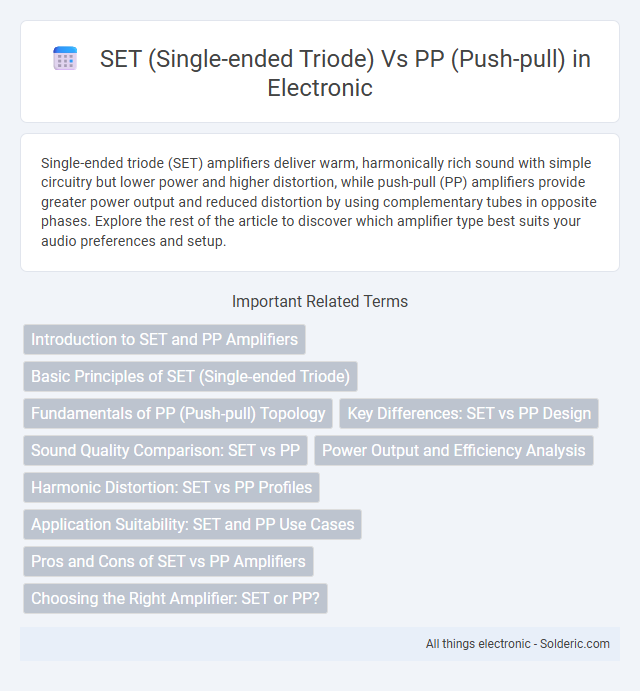Single-ended triode (SET) amplifiers deliver warm, harmonically rich sound with simple circuitry but lower power and higher distortion, while push-pull (PP) amplifiers provide greater power output and reduced distortion by using complementary tubes in opposite phases. Explore the rest of the article to discover which amplifier type best suits your audio preferences and setup.
Comparison Table
| Aspect | SET (Single-Ended Triode) | PP (Push-Pull) |
|---|---|---|
| Topology | Single triode amplifying entire waveform | Two tubes/opposing phases for balanced amplification |
| Sound Characteristics | Warm, rich, harmonic, musical distortion | Cleaner, powerful, lower distortion, neutral |
| Power Output | Low (typically 3-8 watts) | Higher (20+ watts typical) |
| Efficiency | Lower efficiency | Higher efficiency |
| Complexity | Simple, fewer components | More complex circuitry and matching tubes |
| Cost | Generally higher per watt; niche market | More cost-effective at higher power |
| Application | Audiophile, musicality-focused setups | Hi-fi, larger rooms, professional audio |
| Harmonic Distortion | Primarily even-order harmonics | Reduced even-order, balanced distortion |
Introduction to SET and PP Amplifiers
SET (Single-ended triode) amplifiers use a single triode tube for amplification, producing a warm, harmonically rich sound favored by audiophiles seeking purity and simplicity. Push-pull (PP) amplifiers employ pairs of tubes working in tandem to cancel distortion and provide higher power output with improved efficiency. Your choice between SET and PP amplifiers depends on whether you prioritize sonic purity and warmth or power and distortion reduction.
Basic Principles of SET (Single-ended Triode)
Single-ended triode (SET) amplifiers use a single triode vacuum tube to amplify the entire audio waveform, resulting in simplicity and minimal signal distortion. The SET design operates by passing the input signal through one active device, which limits power output but enhances harmonic richness and warm tonal characteristics. This direct amplification method contrasts with push-pull configurations, offering a unique, highly musical performance favored in high-fidelity audio applications.
Fundamentals of PP (Push-pull) Topology
Push-pull topology in audio amplifiers uses two active devices working in tandem, each amplifying opposite halves of an audio signal to reduce distortion and improve efficiency. This configuration naturally cancels even-order harmonic distortions, resulting in clearer sound reproduction and higher power output compared to single-ended triode (SET) designs. Your choice between SET and push-pull devices impacts tonal character and amplifier performance, with push-pull offering greater linearity and reduced noise.
Key Differences: SET vs PP Design
SET (Single-ended triode) amplifiers use a single triode tube operating in class A mode, producing sound with low distortion and rich harmonic content but lower power efficiency and output. Push-pull (PP) amplifiers employ pairs of tubes working in opposite phases, canceling even-order harmonics, enhancing power output and efficiency while reducing distortion. Key design differences include SET's simplicity with one active device versus PP's complexity requiring precise tube matching and phase splitting circuits for balanced operation.
Sound Quality Comparison: SET vs PP
SET amplifiers deliver warm, rich, and harmonically complex sound with smooth midrange and natural tonal balance, favored by audiophiles for their musicality and organic timbre. Push-pull (PP) amplifiers provide higher power output, lower distortion, and better bass control due to efficient cancellation of even-order harmonics, resulting in cleaner and more dynamic sound reproduction. Sound quality preference between SET and PP depends on listener priorities: SET offers a more intimate, euphonic experience while PP excels in accuracy, headroom, and drive capability.
Power Output and Efficiency Analysis
Single-ended triode (SET) amplifiers typically deliver lower power output, often ranging between 3 to 15 watts, but excel in harmonic richness and tonal warmth, making them popular for audiophiles prioritizing sound quality over raw power. Push-pull (PP) amplifiers offer higher power output, sometimes exceeding 100 watts, by using symmetrical transistor or tube pairs that cancel even-order distortion, resulting in greater efficiency and less harmonic distortion. Your choice depends on whether you prioritize the intimate sound character of SET or the higher power and improved efficiency of PP configurations for larger listening environments.
Harmonic Distortion: SET vs PP Profiles
Single-ended triode (SET) amplifiers produce predominantly even-order harmonic distortion, resulting in a warm, musical sound that many audiophiles prefer for its natural tonal balance. Push-pull (PP) amplifiers generate lower overall harmonic distortion by canceling even-order harmonics, but this can introduce odd-order harmonics that some listeners find harsher or less natural. Your choice between SET and PP designs influences the harmonic profile and auditory characteristics, shaping the listening experience according to your tonal preference.
Application Suitability: SET and PP Use Cases
Single-ended triode (SET) amplifiers excel in low-power applications such as high-fidelity headphone amplifiers and audiophile-grade preamplifiers due to their simple design and rich harmonic distortion characteristics. Push-pull (PP) amplifiers are preferred for higher power output scenarios like home theater systems and professional audio equipment, offering improved efficiency and reduced even-order harmonic distortion. SET designs suit environments prioritizing audio purity and warmth, whereas PP configurations handle demanding power needs with greater linearity and control.
Pros and Cons of SET vs PP Amplifiers
SET amplifiers offer a simpler circuit design with low distortion in midrange frequencies and rich harmonic content, providing warm, natural sound preferred by audiophiles, but they suffer from low power output and potential transformer saturation. PP amplifiers deliver higher power efficiency, better linearity, and reduced even-order harmonic distortion, which results in cleaner sound suited for driving demanding speakers, yet they can introduce crossover distortion and sound less "organic" compared to SET designs. The choice between SET and PP depends on factors like desired sound character, power requirements, and speaker sensitivity.
Choosing the Right Amplifier: SET or PP?
Selecting the right amplifier hinges on your audio preferences and listening environment. Single-ended triode (SET) amplifiers deliver warm, harmonically rich sound with gentle clipping, ideal for intimate settings and sensitive speakers. Push-pull (PP) amplifiers provide higher power output and lower distortion, suiting larger rooms or demanding speakers where clean, dynamic performance matters.
SET (Single-ended triode) vs PP (Push-pull) Infographic

 solderic.com
solderic.com